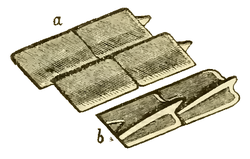A manual of zoology (1902) (20544399878)
Title: A manual of zoology
Identifier: cu31924001021835 (find matches)
Year: 1902 (1900s)
Authors: Hertwig, Richard, 1850-1937; Kingsley, J. S. (John Sterling), 1854-1929
Subjects: Zoology
Publisher: New York, H. Holt and Company
Contributing Library: Cornell University Library
Digitizing Sponsor: MSN
View Book Page: Book Viewer
About This Book: Catalog Entry
View All Images: All Images From Book
Click here to view book online to see this illustration in context in a browseable online version of this book.
Text Appearing Before Image:
55S CHORD AT A. the ' pearl organs.' Enormous numbers of large slime cells give the fishes their "ivoll-known slippery skins. Since the epidermis contributes nothing to the firmness of the body walls, all j^rotective structures arise from the derma, which is composed of many layers of dense connective tissue and furnishes the characteristic dermal skeleton, the scales. These lie at the boundary of ejiidermis and derma, commonly imbedded in joockets of the latter, and are, on account of their different structure, of systematic value, although the classification based entirely upon them is no longer retained. Tlie placoid scales (fig. 5.54, 587, .0 have already been men- tioned, because they form the starting point for dermal ossifica- tions and teeth (p. 51.5). They are rhombic bony pilates, usually close together like a mosaic, but not overlap2iing. In the centre of each is a spine, directed back- wards, in which is a pulp) cavity, while the tip of the spine is cov- ered with a cap of hard substance, variously called enamel or vitro- dentine. The ganoid scales (fig. 587, o) are usually rhomboid and arranged like parquetry. In the early stages they may bear teeth. The outer surface is always covered with a thick layer of ' ganoin,'which gives, even in fossils, an iridescent effect, a most characteristic feature. The ganoin is no longer regarded as enamel, but the most sujierficial layer of dentine (vitrodentine). Cycloid and ctenoid scales are closely related. They are always more loosely jilaced in the pockets, from wliich they are easily witli- drawn as in ' scaling ' a fish. The)' are arranged in oblique, trans- verse, and longitudinal rows, and overlap like shingles, one scale covering the parts of two scales behind. The cycloid scales (fig. 5S7, 1) are ajiproximately circular with a middle j^oint, surrounded by concentric lines, from which go radiating lines. The ctenoid scale (S) has the radial and concentric lines of the cycloid, but has the iiinder edge truncate and the free portion bearing small sjiines or teeth, jirocesses of the concentric ridges. Besides these types of scales many fishes bear considerable
Text Appearing After Image:
Fin -Scales of fislies. i, cyciuid; , ganoid; i, placoid. ctenoid but these are lost in the adult.
Note About Images
Relevantní obrázky
Relevantní články
Šupina (rybovití obratlovci)Šupiny rybovitých obratlovců se nacházejí na povrchu těla a vznikají jako deriváty kůže. Jejich primární funkcí je především ochrana. U různých skupin se vyvinuly různé modifikace šupin, v některých případech dochází k jejich redukci nebo i k úplné absenci. Vyskytují se u ryb a paryb, nikoli však u kruhoústých. Základními typy šupin jsou zašpičatělé plakoidní šupiny paryb, masivní kosmoidní resp. ganoidní šupiny u primitivních svaloploutvých resp. paprskoploutvých ryb a odlehčené pružné cykloidní nebo ktenoidní šupiny moderních ryb, hlavně kostnatých (Teleostei). .. pokračovat ve čtení










